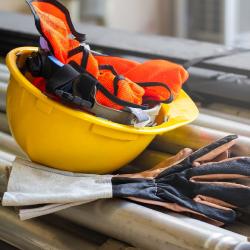
PPE and the world of the craftsman.
Safety is of paramount importance on construction sites. Workers can be exposed to many hazards, such as falls from heights, injuries from power tools, risks from lifting equipment, electrical hazards, chemical hazards and much more.
It is therefore essential that employers, workers and safety professionals work together to ensure that construction sites are safe for all. This can include training in proper safety practices, use of personal protective equipment (PPE), implementation of safety procedures and regular inspection of equipment and facilities for hazards.
Safety on construction sites can not only save lives, but it can also prevent injuries, additional costs and delays in work projects. Ultimately, it is everyone's responsibility to work together to ensure that construction sites are safe for all workers and that every worker can return home safely at the end of each working day.
When working with floor or concrete sanders, it is important to take safety measures to avoid accidents. Personal protective equipment (PPE) is a key element in protecting workers from occupational hazards. In this article, we will review the PPE that is essential to ensure the safety of floor layers and floor craftsmen.
A safety helmet is essential equipment to protect workers' heads from injury. Ground workers should wear a safety helmet to protect themselves from the risk of falling objects, bumps and head impacts, especially when sharing the site with other professionals.
Protective eyewear
Goggles are essential to protect workers' eyes from dust, debris and wood splinters. Ground workers should wear goggles to prevent eye injuries.
Respirators are essential protective equipment to protect workers from toxic dusts, fumes and gases. Respirators can be used to protect against fine wood dust, fumes from processing chemicals and solvent fumes.
The most commonly used respirators are N95 masks, cartridge masks and disposable masks. Disposable masks are a cost-effective option for short-term work. The masks are designed to filter out fine dust particles, while cartridge masks are used to filter out chemical vapours. Masks with a P3 filter use advanced filtration technology to capture the finest particles. P3 filters are effective in filtering out at least 99.95% of particles 0.3 microns or larger, making them an ideal choice for construction, renovation and demolition work.
It is important that floor pavers and tradespeople wear respirators appropriate for the task and follow the manufacturer's instructions for use and care of the respirators. Workers should also ensure that respirators are properly fitted to provide adequate protection and that they are replaced regularly to ensure optimum effectiveness.
In addition to the respirator, workers can also use ventilation systems to remove toxic dusts and fumes. Ventilation systems should be installed by a qualified professional and used according to the manufacturer's instructions.
Protective gloves are essential to protect workers' hands from injury. Floor workers should wear protective gloves to prevent cuts, scrapes and burns.
Protective suits are essential personal protective equipment for sanding, polishing and surface treatment work. Floorers and floor craftsmen should wear protective suits to avoid contact with chemicals, solvents and dusts.
Safety shoes are essential to protect workers' feet from injury. Workers wear safety shoes to avoid the risk of falls, injuries and slips.
The noise generated by the machines used for sanding and polishing can cause hearing damage to exposed workers. To protect themselves from this risk, floor layers and floor craftsmen can wear earplugs or ear muffs.
Floorers and floor craftsmen must wear personal protective equipment (PPE) to protect themselves against the occupational hazards associated with their work. PPE that is essential for their safety includes safety helmets, goggles, breathing masks, protective gloves, protective coveralls, safety shoes, hearing protection and respiratory protection. In addition to PPE, training and awareness-raising are key elements in keeping workers safe.